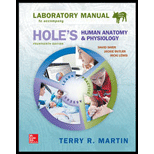
To write:
The major features of the respiratory system.
Introduction:
The respiratory system is the system in which carbon dioxide is exhaled and oxygen is inhaled. A waste product carbon dioxide goes out of the body. The body needs oxygen, comes in. The chief organ to do this is the lungs.
The 1st step in this process is to breathe air or inhale. To breathe (or inhale) means to bring oxygen-rich air in the body. The second stage is the gas exchange in the lungs where oxygen is circulated in the blood and carbon dioxide spreads out of the blood. The third process is
Explanation of Solution
The given figure is the respiratory system.
Below are the main features of the respiratory system are labeled as per the numbers given in the figure
- Nostril:It is one of the two grooves of the nose, from the point where they are parted into the outer opening. They contain branched skeletons or cartilages known as turbinates, whose role is to heat the air when inhaled and to remove moisture during exhalation in mammals and birds.
- Oral Cavity:The oral cavity is defined on the sides and in the front by the alveolar process (with teeth) and by the use of defects on the back. The roof of the oral cavity is formed by a hard palate. The soft palate is found at the back of the hard palate. From the middle of the soft palate, uvula projects down. Its basic function is to act as a gateway to the digestive tract. Another function is to start the digestive process through salivation and propulsion of the digestive bolus in the pharynx.
- Epiglottis:Epiglottis is a leaf-shaped flap found in the throat. It is situated behind the tongue. It is made of elastic cartilage. It restricts the food from entering into the windpipe and the lungs.
- Larynx:It is located below where the pharyngeal tract divides into the trachea and esophagus. It is triangular. Larynx (voice box) attaches the hypopharynx (the inferior portion of the pharynx) to the trachea. It is involved in producing sounds, shielding the trachea against food aspiration, and breathing.
- Bronchus:They are extensions of that windpipe that commute air to and from the lungs. They are the portions of the conducting zone of the respiratory system.
- Lobes of the Right Lung:It is subdivided into three lobes, i.e., an upper, middle and a lower lobe by two fissures (or cleft), one oblique (slant) and one horizontal. The upper, horizontal fissure divides the upper from the middle lobe. The lower, oblique fissure separates the lower from the middle and upper lobes. The mediastinal surface of the right lung is stimulated by several surrounding structures.
- Frontal Sinus:Frontal sinuses are a pair of small, air-filled cavities. It is situated just behind the eyes in the eyebrow area. Thin mucus is produced by these cavities that are drained from the nasal passages along with 3 other pairs of paranasal sinuses.
- Nasal Cavity: The inner space of the nose is called the nasal cavity. The nasal septum splits the cavity into two cavities or fossae. The nasal cavity is the upper portion of the respiratory system. It provides nasal passages from the nasal to the nasopharynx and the air in the rest of the respiratory tract.
- Pharynx:The pharynx (throat) is a muscular tube that joins the oral and nasal cavity to the larynx and esophagus. It is also essential in vocalization. It permits swallowing the food, to speak and to breathe.
- Trachea:Commonly, the trachea is called windpipe. It is a tube of approximately 4 inches in length. The trachea starts just below the larynx and runs behind the sternum (breastbone). The role of the trachea is to remove carbon dioxide and transmit oxygen to the body.
- Lobes of the Left Lung:The left lung is separated into two lobes, i.e., an upper and a lower lobe, through the oblique (or slant) fissure.
Want to see more full solutions like this?
Chapter 45 Solutions
Laboratory Manual for Holes Human Anatomy & Physiology Fetal Pig Version
 Human Anatomy & Physiology (11th Edition)BiologyISBN:9780134580999Author:Elaine N. Marieb, Katja N. HoehnPublisher:PEARSON
Human Anatomy & Physiology (11th Edition)BiologyISBN:9780134580999Author:Elaine N. Marieb, Katja N. HoehnPublisher:PEARSON Biology 2eBiologyISBN:9781947172517Author:Matthew Douglas, Jung Choi, Mary Ann ClarkPublisher:OpenStax
Biology 2eBiologyISBN:9781947172517Author:Matthew Douglas, Jung Choi, Mary Ann ClarkPublisher:OpenStax Anatomy & PhysiologyBiologyISBN:9781259398629Author:McKinley, Michael P., O'loughlin, Valerie Dean, Bidle, Theresa StouterPublisher:Mcgraw Hill Education,
Anatomy & PhysiologyBiologyISBN:9781259398629Author:McKinley, Michael P., O'loughlin, Valerie Dean, Bidle, Theresa StouterPublisher:Mcgraw Hill Education, Molecular Biology of the Cell (Sixth Edition)BiologyISBN:9780815344322Author:Bruce Alberts, Alexander D. Johnson, Julian Lewis, David Morgan, Martin Raff, Keith Roberts, Peter WalterPublisher:W. W. Norton & Company
Molecular Biology of the Cell (Sixth Edition)BiologyISBN:9780815344322Author:Bruce Alberts, Alexander D. Johnson, Julian Lewis, David Morgan, Martin Raff, Keith Roberts, Peter WalterPublisher:W. W. Norton & Company Laboratory Manual For Human Anatomy & PhysiologyBiologyISBN:9781260159363Author:Martin, Terry R., Prentice-craver, CynthiaPublisher:McGraw-Hill Publishing Co.
Laboratory Manual For Human Anatomy & PhysiologyBiologyISBN:9781260159363Author:Martin, Terry R., Prentice-craver, CynthiaPublisher:McGraw-Hill Publishing Co. Inquiry Into Life (16th Edition)BiologyISBN:9781260231700Author:Sylvia S. Mader, Michael WindelspechtPublisher:McGraw Hill Education
Inquiry Into Life (16th Edition)BiologyISBN:9781260231700Author:Sylvia S. Mader, Michael WindelspechtPublisher:McGraw Hill Education





